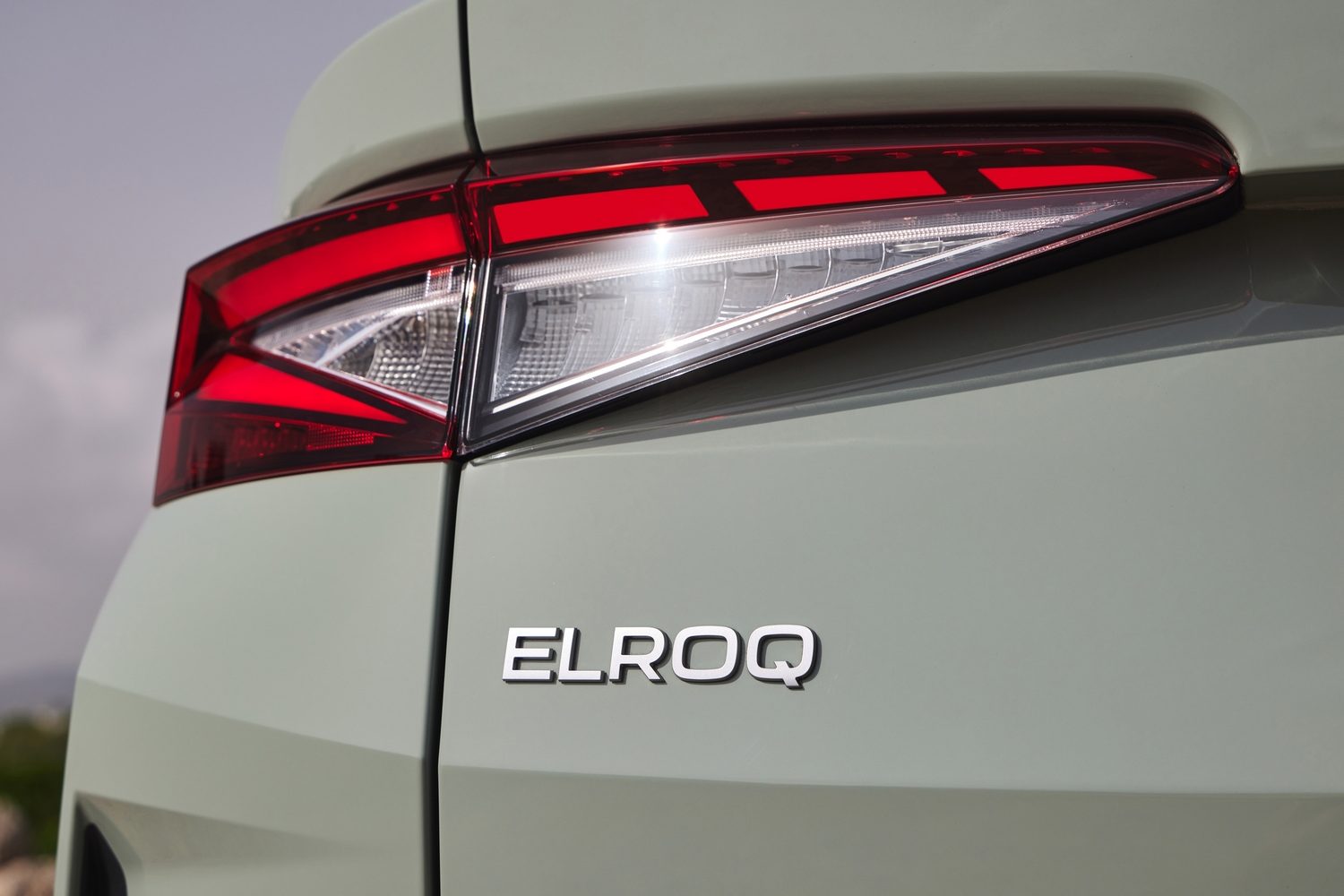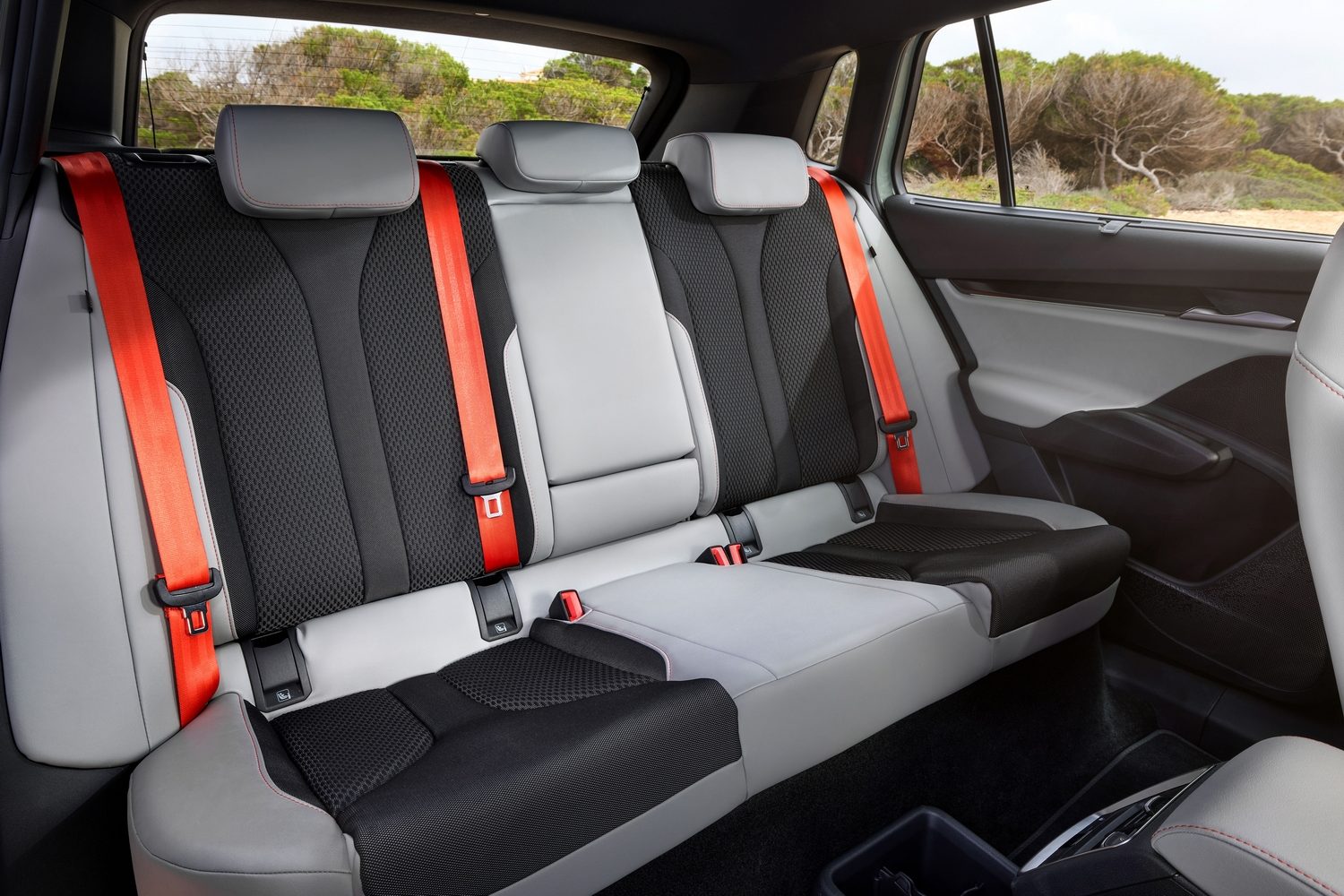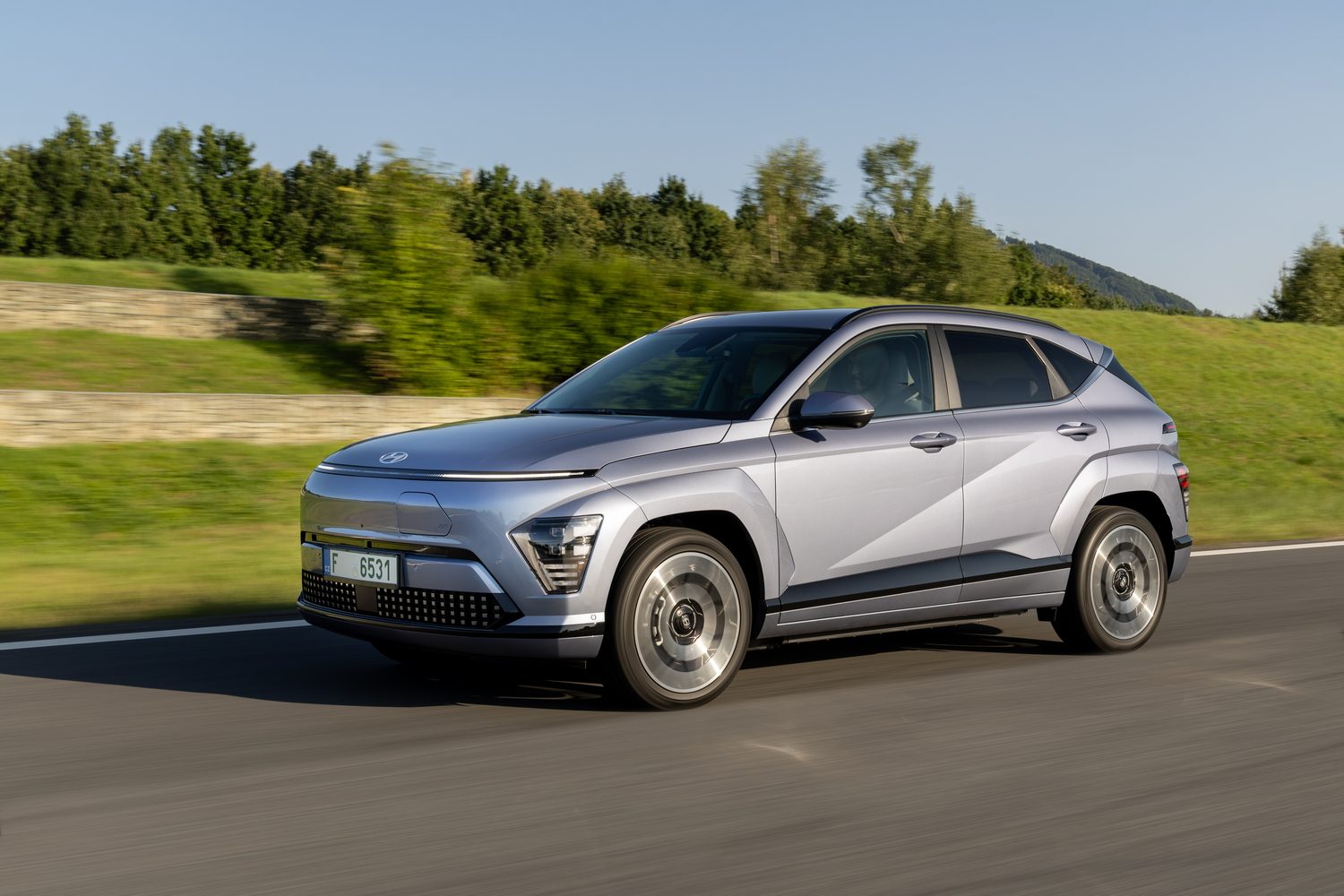Glance at the new Skoda Elroq, and you’ll assume that it’s an electric adjunct to the compact Kamiq SUV. The styling, the shape, the detailing are all quite similar, at least at that first glance. Now try walking up to the Elroq, and suddenly you’ll realise just how big it is. In fact, what you thought to be a compact model is actually about the same size as the current Skoda Karoq, and it’s priced accordingly - the entry-level Elroq 50 we’re testing today is around €1,000 cheaper than the entry-level Karoq. The two cars are, in Skoda’s eyes, peas in a pod, just that one is electric.

Under the Elroq’s ‘Modern Solid’ crossover body (that’s Skoda’s name for its new styling language) there’s the same MEB electric car platform as used by the bigger Enyaq (itself getting a major update in mid-2025) and all of Volkswagen’s ID models.
Skoda has made much of the Elroq’s new styling, but to our eyes it doesn’t look terribly new - you’d certainly not mistake the Elroq for anything other than a Skoda and, even though it lacks the big grille of the Enyaq or Kodiaq, the ‘negative space’ between the main headlight units and below the slim daytime running lights is clearly a chunky grille by another name. The general look of the Elroq is crisp and clean, but not ground-breaking in any particular sense. It’s yet another entry in the medium-sized chunky-SUV ledger.
How much is the Skoda Elroq in Ireland?

Elroq prices start at €36,545 for this most basic Elroq 50 model (although you’ll automatically have to pay an extra €777 for metallic paint) which means a 52kWh battery, a 170hp electric motor and a range of 375km. Standard equipment includes a 13-inch touchscreen, a reversing camera, dual-zone climate control, heated front seats and steering wheel, built in navigation, wireless phone charging, adaptive cruise control, a rear-view camera and all-round parking sensors.
The Elroq 60 - which arrives later in 2025 - gets a 59kWh battery and a 204hp electric motor, and a much more useable range of 440km. It costs from €38,415 and we would have assumed it to be the likely best-seller in the lineup.
Not so, says Skoda Ireland. In fact, Irish buyers are expressing much more interest in the top-line Elroq 85, which costs €42,315 and which has the 285hp electric motor and a range of up to 580km. Apparently Irish buyers don’t trust the public charging network yet and want to make sure that they’ve range to spare.
A Sportline version will follow, as will an 85x model with two electric motors and four-wheel drive, although that is likely to be a minority player in Ireland.

A look inside the Skoda Elroq
Here’s where the Elroq steals something of a march on many of its competitors, as in spite of the car’s relative affordability, I reckon that this is one of the best motoring interiors at any price. Even though we tried the basic ‘Loft’ cabin, with black and dark-grey trim, Skoda has leveraged its use of recycled materials (including discarded fishing nets reworked into soft fabric) to create an interior that’s immediately warm and welcoming. The recycled material that covers the seats and the dashboard lends the cabin an edge of refinement and tactility, and all but a few of the plastic surfaces are of high grade. The two-spoke steering wheel (a three-spoke wheel is standard in the Sportline model) looks and feels excellent, although we lament the loss of the classic Skoda ‘arrowhead’ emblem in favour of Skoda spelled out in letters - something of a sop to the badge-averse Chinese market.
Space and comfort levels up front are excellent. There’s a large storage area under the centre console, and a deep storage bin under the front seat armrest as well. There are two relatively small cup holders, and ahead of those an angled storage space which is home to two wireless phone chargers. The door bins could be a touch wider, perhaps, but they’re reasonably spacious. Visibility is good, thanks to relatively slim windscreen pillars, and there’s a general sense of airiness to the Elroq’s cabin.

In the back, things are at least as good. There’s copious legroom - even if there’s a tall driver sat in the front - and plenty of headroom. The floor is flat, but our test car came with a small storage tray that sat right where a centre-rear seat passenger would put their feet. That centre-rear seat is, as you’d expect, narrow and perched up but it’s tolerable for short journeys. The windows in the back are square and wide, and the belt-line isn’t too high so kids should be able to see out OK. Rear seat comfort is excellent, not least because the seat back is more raked than in some competitors, allowing you to lean back more.
The boot is a good size too, although at 470 litres it’s some 50 litres down on the equivalent petrol-engined Karoq. Still, on the upside there’s a flat load floor, and handy storage trays at either side of the boot, along with flip-down bag hooks. Our test car was specced-up with an optional storage pack, which includes a handy adjustable hammock that can carry delicate items. The storage pack also includes a really neat idea which is a net strung underneath the parcel shelf strong enough (it has a 6kg load limit) to hold the Elroq’s Type 2 charging cable. This at least partially makes up for the lack of a ‘frunk’ in the nose, and the parcel shelf itself is adjustable to two levels, allowing you to divide up the boot as you see fit.
Fold down the back seats - there are no handles in the boot to do this, but it’s easy enough to lean in and flip the catches on the backs of the seats - and there’s 1,580 litres of loadspace, although the rear seat back doesn’t quite go fully flat. Annoyingly, there’s nowhere to stash the parcel shelf when you’re not using it.

How many child seats can I fit in the Skoda Elroq?
Given it’s likely role in life as a family hauler, the Elroq thankfully comes with three ISOFIX locations. Two are in the outer two rear seats, and the third is in the front passenger seat, which of course includes an airbag cutoff switch.

How safe is the Skoda Elroq?
The Elroq hasn’t yet been assessed by Euro NCAP but given the strong safety performance of other models which use this MEB electric car platform, a good result should be forthcoming. The Elroq comes with seven airbags as standard - for the driver and front passenger, head airbags, front side airbags and a central airbag between the front seats; and that can be extended to nine, as rear side airbags are available as an option.
There’s plenty of electronic safety kit too, although a good deal of that is optional rather than standard. One neat wrinkle is that the Elroq constantly draws on ‘swarm’ data from other cars via its connected services setup, which can provide live warnings of any potential dangers on the road ahead, and that information can be sent directly to the standard adaptive cruise control system, automatically slowing as you approach any point of possible trouble. Thankfully, the - often inept - speed limit alert can be turned off without ploughing through a plethora of on-screen menus, too.
The Elroq also has a standard ‘Crew Protection’ system, as part of the anti-collision warning setup, which tightens the seatbelts and winds up the windows if it has worked out that a crash is unavoidable.
The Skoda Elroq’s on-board technology

The Elroq gets a big 13-inch touchscreen as standard, which I reckon is way too big for this car. Thankfully, the Elroq’s on-screen software marks another gradual improvement of the MEB-based model lineup’s tech development. The Elroq’s touchscreen is fairly easy to use and mostly easy to find your way around, although inevitably there are some menu items that seem to be placed in entirely irrational corners of the source code. Having on-screen climate controls is never a good idea, but the Elroq just about gets away with this thanks to the fact that those controls are always present at the bottom of the display.
Helpfully, there are also two customisable shortcut bars at the top and bottom of the screen, allowing you to set up your most commonly-used items for quicker access, and there are at least some physical controls, with a lineup of real buttons below the display which bring you quickly to menu pages such as driving modes, climate control and driver assistance setup.
The driver’s main instruments are the same as those found in the Enyaq, and so are on a relatively small, but clear, seven-inch screen under a small hood behind the steering wheel. These are fine, but better by far is the optional augmented reality head-up display which works brilliantly, and which - when you’re using the navigation - makes big blue arrows seem to hover in the air atop the road ahead, which is a serious boon when tackling unfamiliar roads.

Skoda has also updated its MySkoda app which might make some aspects of electric life a bit easier. For a start, the charging payment system is now integrated in the main app, having previously been a separate app, which at least simplifies things. You can do all the usual tricks such as locking and unlocking the car, setting charging times, controlling the interior heating and cooling, and now you can also set up your home charging point to be controlled via the app.
One new addition is remote parking, which is not just the usual shuffle-forward-a-bit, shuffle-backwards-a-bit stuff. In Elroq models fitted with the full adaptive parking aid, you can actually hop out of the car and control a full turn-and-reverse parking manoeuvre, which could be very handy given the Elroq’s relative bulk and the generally narrowness of city-centre parking spaces.

Driving the Skoda Elroq
The first impression that hits you as you hop aboard the Elroq and head away is... smoothness. As with pretty much every car based on the MEB platform, the Elroq feels liquid-smooth as you pull away.
Sadly, that’s a feeling which doesn’t last, and I suspect the primary culprits are the standard-fit 20-inch alloy wheels. As soon as you hit anything other than pristine tarmac, the Elroq starts to fuss and fidget in a genuinely annoying way. It’s not a hard-riding car - in fact, it’s quite brilliant at absorbing big impacts such as the short and sharp speed bumps that you get in some parts - but unless you’re driving on an immaculate stretch of road, it just never settles down properly. It’s quite unlike the bigger Enyaq, which rides on the same platform and has the same wheelbase.

Certainly, the Elroq’s chunky kerb weight - 1,949kg - must also have a role to play in this unsettled ride, but we can’t help but think that fitting smaller alloys might reduce the problem.
Aside from the ride, the Elroq is entirely pleasant to drive. The steering is well-weighted and quite quick, although it doesn’t provide much feedback for the driver. On tight and twisty roads, the Elroq can get into quite a pleasant rhythm of sweeping from apex to apex, but it’s never quite what you’d call engaging. In that sense, it’s quite like its Karoq sibling - competent and capable, but not a driver’s machine.

Around town, the good visibility helps (as do such items as the parking sensors and the optional surround-view camera, although the rear camera is constantly getting covered in road grime) but the Elroq’s size makes it a bit tricky to thread through tight gaps, especially when you’re trying to keep those 20-inch rims away from kerbs.
On the motorway, the Elroq is in its element - the ride settles down considerably at higher speeds, and there’s hardly any tyre nor wind noise, which, combined with the excellent seat comfort (and the optional Canton stereo), makes for genuinely relaxing long-haul journeys.
What is the Skoda Elroq’s range?

Ah, but can you actually do those long-hauls in an Elroq 50? Well, partially you can... The 52kWh battery’s promise of 375km soon fades, at least in the cool, damp conditions of our test drive. Setting off with a 99 per cent battery charge, the dashboard was displaying 300km of range. While that’s not exactly brilliant (a base Kia EV3 will do closer to 400km in real-world conditions) at least the Skoda is honest. Over a 120km test route which included motorway, city streets, country roads and twisting, fast mountain roads tackled in Sport mode we returned to our base location with 170km of range remaining, so only 10km had gone begging somewhere. Along the route, we averaged 19kWh/100km which isn’t spectacular against the official 15.8kWh/100km figure.
There’s a ‘B’ driving mode which ramps up the regenerative braking effect, but it’s never quite strong enough for true one-pedal driving, and the brake pedal itself can feel a bit spongy at times. Leaving the car in D and switching on the automatic brake energy recuperation setting seems to be a better idea, striking a good balance between control of the car and keeping some juice trickling back to the battery. Switching to Eco mode didn’t seem to make any difference to the displayed range.
The reasons you'd buy a Skoda Elroq

The Elroq is about to enter possibly the most competitive sector of the electric car market. It will be assailed on all sides by direct competition from the Kia EV3 and the existing Hyundai Kona Electric. It will also have to fend off the likes of the Renault Megane and the lower-range version of the big Scenic, not to mention in-house competition from VW’s ID.3.
However, while this particular Elroq 50 suffers from a relatively short range (and that ride comfort issue) the fact is that this is a good enough car that one suspects it might be a key model in unlocking the appeal of electric motoring for the wider car-buying public. Certainly, its interior makes the Elroq stand out with its space, its comfort and its exceptional quality levels. The Elroq’s combination of practicality and reasonable pricing makes it one of the best ways to get family car buyers into battery powered motoring.
Ask us anything about the Skoda Elroq
If there’s anything about the Skoda Elroq we’ve not covered, or you’d like advice in choosing between it and other cars, you can avail of our (completely free) expert advice service via the Ask Us Anything page.






































